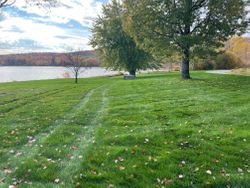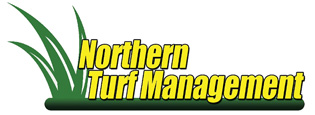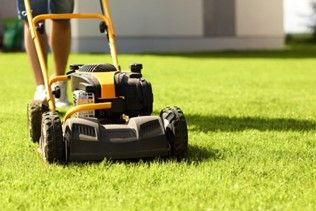With the rain and sun alternating appearances alongside moderate temperatures, our turfgrass is grows vigorously in the early part of the season. While spring is a hectic time of year for anyone working out in the landscape, both do-it-yourselfers and green industry professionals alike, it is essential to keep a few things in mind regarding mowing and turfgrass growth. So, let’s discuss the importance of mowing your Presque Isle & Caribou, Maine lawn and go through a few common misconceptions.
FIRST, WHY IS MOWING SO IMPORTANT?
Mowing is the single most important cultural practice that affects the intensity of all other management practices combined. Specifically, the height of the cut (HOC) affects these changes. As HOC gets progressively lower, the maintenance level is gradually higher. For example, golf course greens may be mowed at 0.10-0.125″, whereas the typical home lawn in Maine is cut at 3-3.5″. It is easy to see that a golf course requires much more maintenance than a residential lawn area. Shorter grass comes with increased pest pressure (weeds, insects, and diseases), shallower roots, increased irrigation requirements, specialized equipment, and so on.
We are lucky that the optimum HOC for residential grass is at the higher end of the spectrum. This factor means that compared to golf and sports turf, the level of maintenance required is much less. However, 60-70% of the lawns I see daily are mowed incorrectly. Not only are they cut too short, but they are also always trimmed in the same direction, with excessive clippings left on the surface. With this in mind, let’s dive into three mowing myths.

Myth #1: “If I Mow My Lawn Shorter, It Will Look More Manicured, Stress The Weeds Out More Than The Grass, And I’ll Have To Mow Less Often.”
There are multiple issues combined here, so let’s take it one at a time. First, many folks believe that mowing shorter gives their lawn a more manicured look, like a golf course. While it is all right to have that opinion, there are only so many reasons to mow your lawn shorter than the recommended HOC range.
Let’s go back to the cultural intensity scale for a second. Remember how short-cut golf/sports turf requires much more maintenance than lawn-height turf? So if you mow your lawn closer to one inch rather than three but don’t follow it up with the increased care associated with an area typically cut at that height, your turf will suffer. In addition, most turf surfaces that get mowed at low HOCs are extraordinarily uniform and do not have many dips, divots, hills, and generally uneven areas that lawns can have.
Therefore, if you mow an uneven lawn area at a lower-than-recommended HOC, it is almost certain that you will experience some degree of scalping. In the best-case scenario, if the crowns of the grass plants are not damaged, it will still take weeks for them to heal. In the worst case, mowing will damage the crowns, and the death of the grass in those areas is imminent.
MOWING YOUR LAWN SHORT WON’T PREVENT WEEDS.
Many folks also believe that mowing their lawn shorter will stress out the weeds and help to provide “natural” weed control. This is the opposite of the truth. Mowing higher, within the recommended range, will not only help to shade and choke out weeds but also shade the soil from drying out, provide ampler protection to the crown of the plant, and provide an overall healthier appearance.
Finally, those who mow their lawn short believe they are reducing their mowing frequency. Before I speak about the specifics of this facet of HOC, it is crucial to understand the 1/3 rule. This rule states that when mowing, you should remove no more than 1/3 of the total plant height at any one mowing event or, equivalently, remove no more than 1/2 of the HOC at any one mowing event.
For example, if you want to maintain your lawn at a HOC of 3 inches, you should allow up to 1.5 inches of new growth to accumulate between mowing events. So, going back to our original point on the mowing frequency and based on what we now know about the 1/3 rule, mowing your lawn shorter increases the frequency at which you will need to trim to maintain uniformity without violating the 1/3 rule.

Myth #2: “If I Can’t Get Around To Mowing My Lawn For A Little While, And I Know That Because It’s Long, There Will Be Excessive Clippings Once I Mow, I Can Bag The Clippings, And Everything Will Be Fine. Besides, Leaving The Clippings On The Lawn Promotes Excessive Thatch Development Anyway.”
While the grass may not look noticeably different initially, repeated violations of the 1/3 rule will be detrimental to overall turf health. They will cause it to miss out on the benefits of regular mowing and moderate levels of grass clippings that consistently get returned to the turf system. Regular turf mowing promotes greater leaf density to compensate for temporary defoliation. It also encourages increased resiliency and cushioning within the turf system.
However, removing large amounts of leaf tissue at once can shock the grass plant. It can also cause a dull, whitish/brown cast over the turf, as allowing turf to grow excessively before mowing can sometimes mean that seedheads will form, and along with them comes the thicker flower stem and leaf parts. This growth reduces the turf’s refined appearance.
It is understandable that sometimes despite our best efforts to keep up, violations of the 1/3 rule will occur due to weather, scheduling issues, equipment breakdown, etc. Clippings may inevitably be excessive when this happens, and some may have to be removed. However, if the remaining clippings are not in heaping piles on your lawn, why not simply spread them around with a leaf blower?
This method is often sufficient; it removes the clippings from view, but they remain within the turf system. Contrary to popular belief, grass clippings left on the lawn don’t contribute to excessive thatch. If you do leave your grass clippings after mowing for the entire season, it is equivalent to an additional 0.8 lbs of nitrogen per 1000 square feet. That’s free fertilizer!

Myth 3: “The Direction I Mow Only Affects How Good My Lawn Looks. There’s No Way That It Can Affect My Lawn’s Health– It’s Purely Cosmetic!”
First, let’s discuss mowing direction/patterns. Up to a certain point, this is primarily an aesthetic problem but can quickly become a turf health issue. While your mowing pattern doesn’t have to rival the elaborate designs of centerfield at Fenway Park, changing directions at every mowing is a massive benefit to the turf. This change avoids compaction and the creation of ruts from traveling the same path each time.
Over time, you’ll notice this compaction forcing your grass blades to lay flat on the ground. First, this compaction doesn’t look good, but it also isn’t good for your lawn’s health. In the winter, this compaction can encourage the growth of snow molds because excessive moisture gets trapped in the grass. Plus, your grass will lose its overall efficiency at processing nutrients and won’t thrive at its best.
Ruts are also damaging to your lawn. When the soil is moist, your mower is far more likely to create dips in the yard that crush grass and kick up dirt. You may even have to reseed these areas to replenish the grass. Also, avoid excessive overlap of your mowing passes; this wastes time and covers up any pattern you hope to create on your lawn.
Finally, a straightforward but meaningful tip: keep your blades sharp! Dull blades shred the grass rather than cleanly shearing it. This shredding not only creates a whitish cast over your entire lawn but creates an entry point for disease organisms to infiltrate the grass plants.

MOW LIKE A PRO WITH NORTHERN TURF MANAGEMENT’S LAWN CARE TIPS.
Now that you know the basics of proper mowing, follow them, and your turf will thank you! Remember the common myths homeowners have about mowing as you mow your lawn this spring. By learning the truth about proper mowing, you’ll be able to tend to your property more efficiently than ever before. If questions arise, don’t hesitate to ask your local lawn care experts.
Searching for professional lawn care that’ll leave your grass glowing? Our Maine lawn care team at Northern Turf Management can keep your grass green, thick, and weed-free so you can relax with your family this spring. Reach us at (207) 544-9420 to learn more about our lawn care services.

